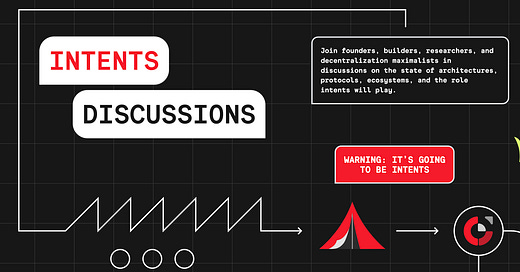A little bit of chit-chat
We will curate the ZK Track at Modular Summit on July 13th at the Canvas Stage. There will be talks and panels with teams shaping the Modular Ecosystem with ZK tech. Get your tickets here.
Stargaze announced that all featured collections will mint ATOM in August as part of the Atom Accelerator DAO grant for ATOM minting on Stargaze.
Intents Discussions Notes
To kick off the EthCC week, Anoma put together an event about Intents. The event featured a series of presentations, panel discussions, and interactive sessions, all focused on exploring the various facets of Intents. Here are our notes on Intents Discussions:
For starters, what are Intents? The event kicked off with an introductory session explaining the concept of Intents. Awa Sun Yin from Anoma defines Intents as high-level user directives that blockchain applications interpret and execute. This approach shifts the focus from specifying each transaction step to defining the desired outcome, allowing the system to determine the optimal execution path.
The Good
Improved User Experience
One of the primary points highlighted during the event was the improvement in Intents' user experience. Several speakers emphasized the following aspects:
Abstraction of Complexity: Users can issue commands without in-depth knowledge of blockchain mechanics. This was demonstrated through a live demo where a non-technical user successfully executed a complex transaction by specifying the desired outcome.
Automated Execution: Intents automate the decision-making process, enabling seamless execution of multi-step transactions. A panel discussion elaborated on how this reduces the likelihood of errors and increases efficiency, showcasing real-world examples from existing applications.
Enhanced Security
Security was a major theme throughout the event. Multiple sessions addressed how Intents can enhance security in blockchain transactions:
Minimized User Intervention: By reducing manual steps, Intents decreases human error risk and potential security breaches. A cybersecurity expert provided insights into how this could protect users from common pitfalls in blockchain interactions.
Standardization and Verification: The potential for standardized Intents to facilitate better security practices was discussed. An industry leader shared their vision for a future where Intents undergo straightforward verification processes, ensuring safer transactions.
Interoperability and Integration
The event also delved into how Intents could foster interoperability and integration within the blockchain ecosystem:
Cross-Chain Operations: Presenters discussed how Intents could enable easier interaction across different blockchain networks. A notable example included a project using Intents to bridge operations between two major blockchain platforms.
Protocol Agnosticism: By focusing on outcomes, Intents can be designed to work across various protocols. This was illustrated through several case studies showing successful integrations across different blockchain technologies.
The not-so-good
Technical Challenges
While the potential of Intents was widely acknowledged, several technical challenges were also discussed:
Standardization: Establishing universal standards for defining and interpreting Intents was identified as crucial. An expert panel debated various approaches to achieve this.
Scalability: Ensuring systems can handle a high volume of Intents without degrading performance was another critical issue. A research team presented ongoing work aimed at addressing scalability concerns.
Security Protocols: The development of robust security protocols for the automated execution of high-value transactions was emphasized. A security session highlighted current efforts and future directions in this area.
Conclusion
The event concluded with a forward-looking session on the future of Intents in the blockchain ecosystem. Participants agreed that while the technology is still in its early stages, its potential to simplify user interactions, enhance security, and promote interoperability is promising. The consensus was that ongoing research, development, and industry collaboration will be essential to overcome current challenges and unlock the full benefits of Intents.
You can watch the whole event here.
Penumbra Exists
Penumbra is undergoing a phased mainnet launch. The process includes several critical stages designed to ensure stability and security.
The first phase, "Genesis," involves the creation of the genesis block, setting the foundation for the network's operation. During this phase, core functionalities such as transaction validation and consensus mechanisms are activated.
The second phase, "Bootstrap," focuses on network stability and security. Validators are onboarded to participate in consensus and secure the network. Initial tests ensure that the network functions as intended under real-world conditions.
The third phase, "Soft Launch," expands participation to a broader range of stakeholders. This phase allows for increased transaction volume and stress testing of the network. Feedback from participants is crucial for identifying and addressing potential issues.
The final phase, "Full Launch," opens the network to the public. All functionalities, including staking, governance, and privacy features, are fully operational at this stage. The network is expected to handle regular user activity and transactions, marking the completion of the mainnet launch process.
Wrap Up
If you like our newsletter, share it with your friends so they can also stay informed about the latest and greatest (and sometimes not so great) of the Cosmos ecosystem.
In the meantime, feel free to follow us on Twitter @zkv_xyz and visit our website to stake with us.





